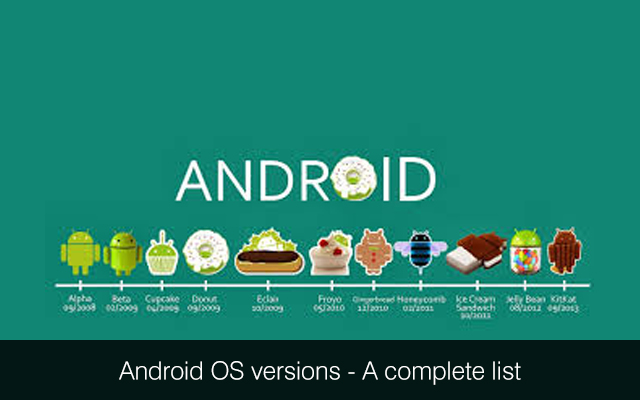sdfhadkjf aklsfdjasklfAccording to an International Data Corporation press release, “Android will undoubtedly remain the clear market leader among smartphone operating systems with share expected to hit 80.2% in 2014.” The hugely popular Google mobile operating system was originally designed based on the Linux kernel for touch screen devices. But at present, Android is being used by wrist watches (Android Wear), televisions (Android TV), cars (Android Auto) and other specialized interfaces along with smartphones, tablets and phablets. The huge popularity of the mobile operating system can be attributed to a variety of factors. But each version of Android contributed towards enhancing its popularity and global market share. Each version of the mobile operating system interestingly has a dessert-based nickname.

About Major Commercial Versions of Android
Cupcake (Android 1.5): Android 1.5 SDK was releases in April 2009. Cupcake considered beginning the era of the modern Android phone. It was also the first revamped version of the mobile OS that came with many UI changes. The version 1.5 also supported widgets and folders on the home screen. At the same time, Cupcake also included camcorder support, improved Bluetooth support, and upload services like Picasa and YouTube.
Donut (Android 1.6): In September 2009, Donut was released. It was built based on the features of Android 1.5, while expanding the features. Some of the behind the scene improvements were not even noticeable by end users. But it allows users to initiate universal search and access the Android Market. At the same time, Donut also supported improved camera, galleries, and higher resolution touchscreens. Donut is considered to provide the framework base for future updates.
Eclair (Android 2.0/2.01/2.1): Éclair, released in late 2009, is considered to be major step up over earlier versions. The Android 2.0 came with a new user interface (UI), an improved web browser and Google Maps. Google Maps enable the platform to compete with other stand-along GPS navigation systems. Google further updated Éclair with additional features and bug fixes.
Froyo (Android 2.2): Google announced Froyo in May 2010 at the Google IO Conference. The Android 2.2 came with a Just-In-Time (JIT) Compiler to drastically improve the processing power of devices. Froyo further supported Adobe Flash 10.1. So the users now have option to access their Flash-based content and games on the mobile web browser. Froyo also supported tethering to enable users to provide internet connectivity to any device from their Android smartphone's data connection.
Gingerbread (Android 2.3): Gingerbread was released in December 2010 with several UI improvements and support for new technologies. The UI improvements to Android resulted in making the menus, dialogs and notification bars feel consistent. At the same time, Gingerbread also supported innovative technologies like Near Field Communication (NFC) and Internet Calling (SIP). Android 2.3 also came with an optimized JIT compiler and battery life.
Honeycomb (Android 3.X): Honeycomb was the first Android version that was designed for tablets. IT was released in February 2011 with a set of new elements for tablets. Along with the new recent apps button, Honeycomb also came with the updated Gmail and Talk apps. The Talk app makes it easier for tablet users to video chat. Honeycomb was released under Google’s new distribution method. The distribution method required the device manufacturers to get their hardware choices approved by Google to obtain the required source code and license.
Ice Cream Sandwich (Android 4.0): Google released Android 4.0 in December 2011. Ice Cream Sandwich was designed to bring some of the design elements of Honeycomb to smartphones, while refining the user experience. However, Google subsequently updated Android 4.0 for both smartphones and tablets.
Jelly Bean (Android 4.1-4.3): Jelly Bean was released by Google in 2012. Google also releases Android versions 4.1, 4.2 and 4.3 within a shorter span of time. It included the polished UI design along with several new features. Jelly Bean is also the first version of Android that came with lock screen widgets, actionable notifications, multi-user accounts support and quick settings in the notification bar. The combination of customization options and useful services make Jelly Bean the turning point for the Google mobile operating system.
Each updated version of Android comes with several additional and improvements. Google has unveiled the next version of the mobile operating system with the working title of Android L. But the formal version of Android L is expected to release by late 2014. If you are planning to hire service of Android development company India, you must evaluate them to see if they are sufficiently agile or not!
We provide Android app programming services. If you would like to talk one of our certified Android app developers for hire, please get in touch with us at Mindfire Solutions.

/image%2F1058540%2F20140523%2Fob_9762b0_profile-pic.jpg)